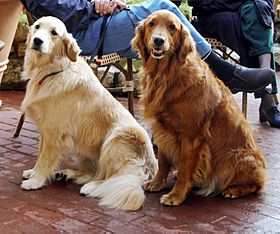Therapy dog facts for kids

Therapy dogs are dogs used to comfort people who are ill or disabled.
A therapy dog is trained to provide affection, comfort and support to people, often in hospitals, retirement homes, nursing homes, schools, libraries, hospices, or disaster areas. In contrast to assistance dogs, which are trained to assist specific patients with their day-to-day physical needs, therapy dogs are trained to interact with all kinds of people, not just their handlers.
In the late 1800s, Florence Nightingale observed that small pets helped reduce anxiety and improve recovery in children and adults living in psychiatric institutions. Sigmund Freud began using his own pet dog to improve communication with his psychiatric patients in the 1930s. More recently, Elaine Smith established the first therapy dog organization in 1976. During her work as a registered nurse she noticed positive effects of dogs on hospital patients.
Contents
Types
There are three tupes of therapy dogs. The most common type are therapeutic visitation dogs. These dogs are usually household pets; the owner of these dogs will take their pets to hospitals, nursing homes or rehabilitation facilities to visit patients. These dogs are used to improve the mental health of patients through socialization and encouragement.
Another type of therapy dog is animal-assisted therapy dogs (AAT). Dogs who fall under this category provide assistance to patients to reach certain goals towards their recovery. They work to help patients gain skills such as motor skills, use of limbs and hand-eye coordination. They do this by walking patients through certain activities and games to help them practice these skills. These dogs are usually based in rehabilitation facilities.
The last type of therapy dog is a facility therapy dog. These dogs usually work in nursing homes along with their handlers. They live at the facility and help patients with Alzheimer's disease and other cognitive and mental illnesses.
Certification
In order for a dog to be a good candidate to become a therapy dog and receive certification, they should be calm and social with strangers. They should also be able to adjust to loud noises and fast movements.
There are certain steps that are needed for a dog to become certified by a national organization such as The Alliance of Therapy Dogs, e.g., to socialize the dog around other animals and people. They are tested on behaviors such as not jumping on people and being able to walk on a loose leash. Some organizations offer classes such as "distraction-proofing", which strengthens the dog's ability to focus and therapy training to help prepare the dog and the dog's owner for therapy visits.
Although therapy dogs are not limited to a certain size or breed, common breeds used in therapy dog application and research include the Golden Retriever and the Labrador Retriever. Cavalier King Charles Spaniels are considered natural therapy dogs since they were bred to be companion dogs. They love meeting new people including children, are very gentle, and are eager to sit on someone's lap for long periods of time and are small enough to do so.
Therapy dogs offer many benefits to people and patients. For example, therapy dogs help patients participate in physical activities. They also help encourage them to have cognitive, social, and communication goals.
Images for kids
-
Greyhound therapy dogs in an elementary school in North Port, Florida
See also
 In Spanish: Canoterapia para niños
In Spanish: Canoterapia para niños


